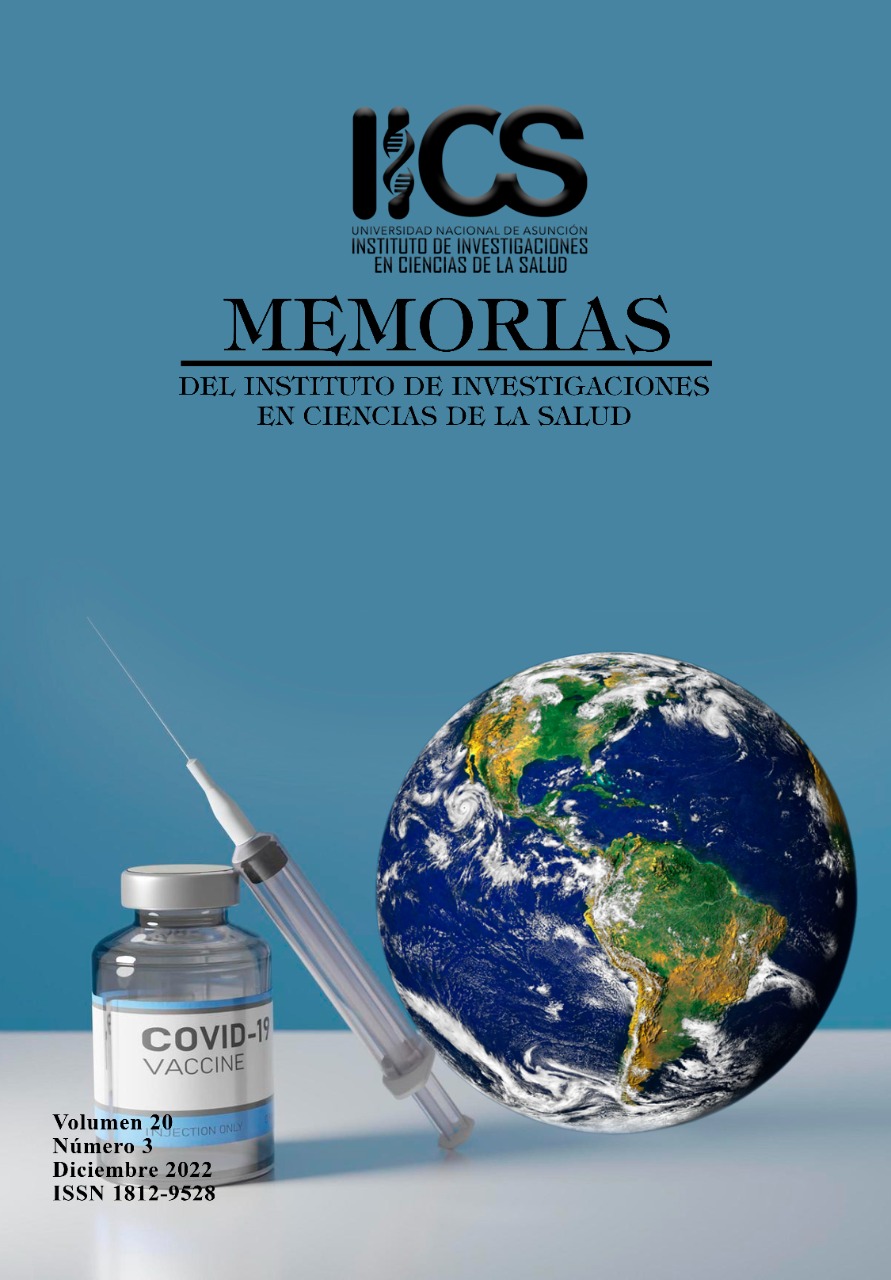Distribución de virus de papiloma humano de alto riesgo oncogénico y otras infecciones de transmisión sexual en mujeres paraguayas con y sin virus de la inmunodeficiencia humana
DOI:
https://doi.org/10.18004/mem.iics/1812-9528/2022.020.03.134Keywords:
infección de transmisión sexual (ITS), virus de papiloma humano de alto riesgo oncogénico (VPH-AR), virus de inmunodeficiencia humana (VIH)Abstract
El virus de papiloma humano de alto riesgo oncogénico (VPH-AR) es causa necesaria pero no suficiente para la ocurrencia de cáncer de cuello uterino (CCU). Mujeres portadoras del virus de inmunodeficiencia humana (VIH) presentan mayor riesgo de desarrollar lesiones precursoras del cáncer de cuello de útero, por ello, el objetivo del presente trabajo prospectivo de corte transversal fue determinar la frecuencia de VPH-AR y otras infecciones de transmisión sexual-ITS (condilomas, sífilis, virus del herpes simple, gonorrea, citomegalovirus, hepatitis B) en 218 mujeres con y sin VIH que acudieron al Programa Nacional de Lucha contra el SIDA (PRONASIDA) desde julio 2017 hasta marzo 2021. Se encontró que 16/54 (29,6%) mujeres VIH-positivas presentaron infección por VPH-AR en comparación a 41/164 (25%) mujeres VIH-negativas (p>0,05). En relación a la edad, mujeres VIH positivas presentaron una frecuencia comparable de infección por VPH-AR (<30 años: 27,3% vs >30 años 30,2%), a diferencia de mujeres VIH negativas donde hubo una disminución significativa de la infección por VPH-AR luego de los 30 años (<30 años: 33,8% vs >30 años 18,8%, p= 0,028). Esto podría explicarse por la inmunosupresión observada en mujeres VIH positivas que podría favorecer infecciones persistentes, sugiriendo que deben ser controladas más cercanamente. Además, se observó mayor frecuencia de otras ITS en mujeres VIH positivas (29,6% vs 15,8%, p=0,026), lo cual sugiere que aparte del monitoreo más cercano, es fundamental fortalecer la educación sobre factores de riesgo para la ITS sobre todo VPH y VIH, así como la realización de prevención primaria por vacunación contra el VPH.
Downloads
References
De Sanjosé S, Brotons M, Pavón MA. The natural history of human papillomavirus infection. Best Pract Res Clin Obstet Gynaecol. 2018; 47:2-13.
Sung H, Ferlay J, Siegel RL, Laversanne M, Soerjomataram I, Jemal A, et al. Global Cancer Statistics 2020: GLOBOCAN Estimates of Incidence and Mortality Worldwide for 36 Cancers in 185 Countries. CA Cancer J Clin. 2021 May;71(3): 209-49.
Szymonowicz KA, Chen J. Biological and clinical aspects of HPV-related cancers. Cancer Biol Med. 2020 Nov 15;17(4):864-78.
Tso FK, Rodrigues CL, Levi JE, Mattosinho de Castro Ferraz MG, Speck NM, et al. HPV infection-associated anogenital cyto-colpo-histological findings and molecular typing in HIV-positive women. Genet Mol Res. 2015 ;14(4):17630-40.
Bobadilla ML, Villagra V, Zorrilla ME, Olmedo G, Riveros MC, Franco F. et al. Detección y tipificación del Virus Papiloma Humano en el marco del tamizaje virológico para la detección de lesiones del cuello uterino en Asunción, Paraguay. Mem. Inst. Investig. Cienc. Salud. 2019; 17(1): 6-15.
Bruni L, Diaz M, Castellsagué X, Ferrer E, Bosch FX, de Sanjosé S. Cervical human papillomavirus prevalence in 5 continents: meta-analysis of 1 million women with normal cytological findings. J Infect Dis. 2010 Dec 15;202(12):1789-99.
Forman D, de Martel C, Lacey CJ, Soerjomataram I, Lortet-Tieulent J, Bruni L, et al. Global burden of human papillomavirus and related diseases. Vaccine. 2012 Nov 20;30 Suppl 5:F12-23. doi: 10.1016/j.vaccine.2012.07.055. PMID: 23199955.
Kasamatsu E, Rodríguez Riveros MI, Soilan AM, Ortega M, Mongelós P, Páez M, et al. ESTAMPA Paraguay Center study group. Factors associated with high-risk human papillomavirus infection and high-grade cervical neoplasia: A population-based study in Paraguay. PLoS One. 2019 jun. 27;14(6).
Clifford GM, Tule S, Franceschi S. Carcinogenicity of Human Papillomavirus (HPV) Types in HIV-Positive Women: A Meta-Analysis From HPV Infection to Cervical Cancer. Clin Infect Dis. 2017 May 1; 64(9):1228-35.
Ahdieh L, Klein RS, Burk R, Cu-Uvin S, Schuman P, Duerr A, et al. Prevalence, incidence, and type-specific persistence of human papillomavirus in human immunodeficiency virus (HIV)-positive and HIV-negative women. J Infect Dis. 2001 Sep 15;184(6):682-90.
Ministerio de Salud Pública y Bienestar Social. Informe Situación Epidemiológica del VIH y SIDA Paraguay 2021 [Internet]. 2021 [Acceso 12 de Octubre de 2022]. Disponible en: https://www.mspbs.gov.py/dependencias/pronasida/adjunto/5e8632-InformeEpidemiolgicoVIH2021.pdf
Castle PE, Einstein MH, Sahasrabuddhe VV. Cervical cancer prevention and control in women living with human immunodeficiency virus. CA Cancer J Clin. 2021 Nov;71(6):505-26
Ceccato Junior BP, Lopes AP, Nascimento LF, Novaes LM, Melo VH. Prevalence of cervical infection by human papillomavirus and cervical intraepithelial neoplasia in HIV-positive and negative women. Rev Bras Ginecol Obstet. 2015 ;37(4):178-85.
Zeier MD, Botha MH, Engelbrecht S, Machekano RN, Jacobs GB, Isaacs S, et al. Combination antiretroviral therapy reduces the detection risk of cervical human papilloma virus infection in women living with HIV. AIDS. 2015 Jan 2;29(1):59-66.
Saslow D, Solomon D, Lawson HW, Killackey M, Kulasingam SL, Cain J, et al. American Cancer Society, American Society for Colposcopy and Cervical Pathology, and American Society for Clinical Pathology screening guidelines for the prevention and early detection of cervical cancer. CA Cancer J Clin. 2012; 62(3): 147-72.
WHO guideline for screening and treatment of cervical pre-cancer lesions for cervical cancer prevention [Internet]. [citado 10 de noviembre de 2022]. Disponible en: https://www.who.int/publications-detail-redirect/9789240030824 .
Global Cancer Observatory IARC, (Internacional Agency for Research in Cancer) https://gco.iarc.fr/today/home (Acceso Marzo de 2022).
Mendoza L, Mongelos P, Páez M, Castro A, Rodriguez Riveros I, Gimenez G, et al. Human papillomavirus and other genital infections in indigenous women from Paraguay: a cross-sectional analytical study. BMC Infect Dis. 2013; 13:531.
Caballero Gómez SV, Mendoza Torres LP, Orihuela SE,Valenzuela Caceres AB. Infecciones de transmisión sexual en mujeres de edad fértil usuarias del Hospital Regional de Villa Hayes, Paraguay. Mem. Inst. Investig. Cienc. Salud; 2015, 13 (2), 30-49.
Zayats R, Murooka TT, McKinnon LR. HPV and the Risk of HIV Acquisition in Women. Front Cell Infect Microbiol. 2022 Feb 10;12:814948. doi: 10.3389/fcimb.2022.814948.
Ministerio de Salud Pública y Bienestar Social. Programa Nacional de Control de SIDA /ITS Manual de Manejo de la Infección por VIH y Tratamiento Antirretroviral en Adolescentes y Adultos 2017-2018 [Acceso 2 de Abril de 2022]. Disponible en: https://www.mspbs.gov.py/pronasida/nmanuales.html .
Garcia F, Alvarez M, Bernal C, Chueca N, Guillot V. Diagnóstico de laboratorio de la infección por el VIH, del tropismo viral y de las resistencias a los antirretrovirales. Enfermedades infecciosas y microbiologia clinica. 2011; 29(4): 297-307.
Ministerio de Salud Pública y Bienestar Social. Informe Situación Epidemiológica del VIH y SIDA Paraguay 2019 [Internet]. 2019 [Acceso 20 de Octubre de 2019]. https://www.mspbs.gov.py/dependencias/pronasida/adjunto/d429aa-InformeEpidemiolgicoVIH20191.pdf
Ministerio de Salud Pública y Bienestar Social. Informe Situación Epidemiológica del VIH y SIDA Paraguay 2020 [Internet]. 2021 [Acceso 20 de Octubre de 2020]. https://www.mspbs.gov.py/dependencias/pronasida/adjunto/46a268-InformeEpidemiolgicoVIH2020.pdf
Pérez-González A, Cachay E, Ocampo A, Poveda E. Update on the Epidemiological Features and Clinical Implications of Human Papillomavirus Infection (HPV) and Human Immunodeficiency Virus (HIV) Coinfection. Microorganisms. 2022 May 18;10(5)
Zeier MD, Botha MH, Engelbrecht S, Machekano RN, Jacobs GB, Isaacs S, et al. Combination antiretroviral therapy reduces the detection risk of cervical human papilloma virus infection in women living with HIV. AIDS. 2015 Jan 2;29(1):59-66.
Serrano B, Brotons M, Bosch FX, Bruni L. Epidemiology and Burden of Hpv-Related Disease. Best Practice & Research. Clinical Obstetrics & Gynaecology 2018, 47, 14-26
Schiffman M, Wentzensen N, Wacholder S, Kinney W, Gage JC, Castle PE. Human papillomavirus testing in the prevention of cervical cancer. J Natl Cancer Inst. 2011 Mar 2;103(5):368-83.
Abraham AG, D'Souza G, Jing Y, Gange SJ, Sterling TR, Silverberg MJ, et al.; North American AIDS Cohort Collaboration on Research and Design of IeDEA. Invasive cervical cancer risk among HIV-infected women: a North American multicohort collaboration prospective study. J Acquir Immune Defic Syndr. 2013 Apr 1;62(4):405-13
Zhao R, Liang S, Teoh D, Fei Y, Pang X, Kulasingam S. A comprehensive cross-sectional survey to identify barriers and facilitators of cervical cancer screening in women with HIV in Guangxi, China. Infect Agent Cancer. 2022 Mar 24;17(1):12.
Liu G, Sharma M, Tan N, Barnabas RV. HIV-positive women have higher risk of human papilloma virus infection, precancerous lesions, and cervical cancer. AIDS. 2018 Mar 27;32(6): 795-808.















